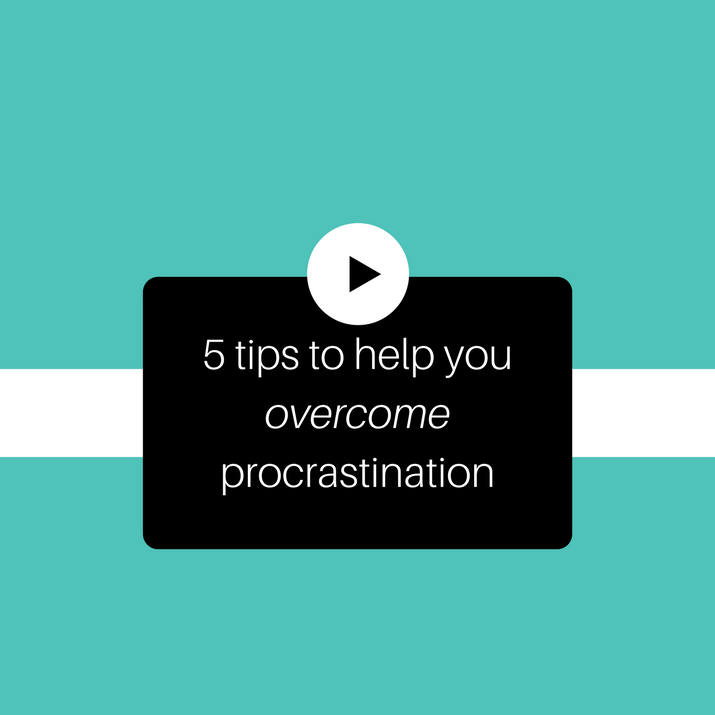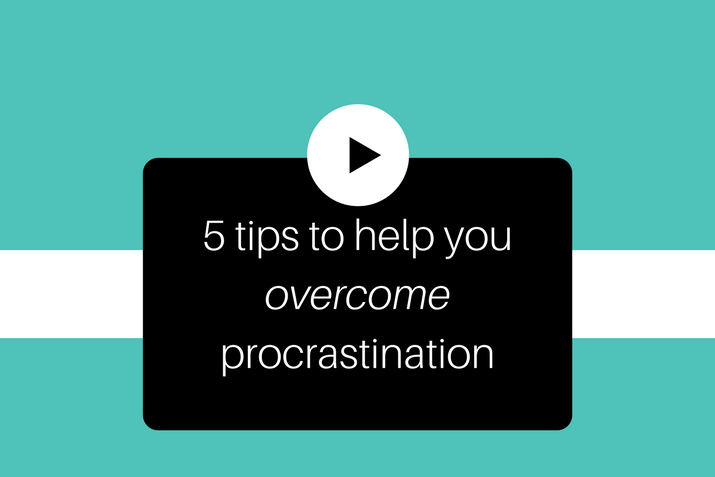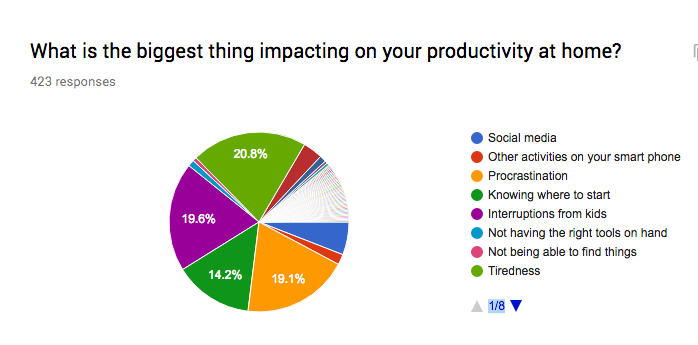This post is part of a series on productivity. You can find more posts in the series here.
In the PWK annual survey of 2016, I asked “What is the biggest thing impacting on your productivity at home?” and one of the biggest factors nominated by readers was procrastination.
I think we all suffer from varying levels of procrastination at some point. Procrastination can take a variety of forms, so before I share my tips for overcoming procrastination, I thought I would shine a spotlight on what procrastination can look like:
- Productive procrastination – this is where you are not doing the tasks you should be doing, but are still working on things that need to get done. For example, you may have a stack of household paperwork to complete, including bills at their due date, but you decide to declutter the pantry. Sure it was due for a declutter, but you are either going to have to attack that paperwork at some point on that day or there will be late fees to pay.
- Organisational procrastination – you have a full day ahead of you, so you decide to write up a list of all the things you need to do. You colour code, use post it notes, make it look pretty and spend an hour organising your work before you even think about taking action.
- Overwhelmed procrastination – the task or tasks you have to do fill you with such overwhelm, that you take any opportunity to avoid starting them or you don’t even know where you would start with them. Someone asks you for a coffee after school drop off and you accept. You take a quick look at Pinterest for inspiration for a recipe to cook for that night’s dinner but some how end up spending 45 minutes looking at summer wardrobe capsules.
- Tired procrastination – you feel tired and have little energy, but you know you need to complete certain tasks. You start putting on a load of washing, but halfway through find a toy in one of the kid’s pockets, so return it to their room. While there, you look around the room, pick up a piece of writing by one of the kids and sit down and read it. Sitting makes you feel even more tired so you go the kitchen to make a coffee and check your phone while waiting for the kettle to boil. 30 minutes later the load of washing eventually is on and going.
- Fearful procrastination – you have had a task on your list for some time. You need to ring someone or do something that takes you out of your comfort zone. You know you need to do it, you think about what you need to say or do. You consider options, run through scenarios, you begin talking up the task to be much bigger than it actually is. Then feeling quite fearful or anxious about the task, you decide today isn’t the day to do it because of reason a, b and c.
It is easy for me to write the above as I have in my time, ticked off every single one of these procrastination types and there are still moments where I catch myself procrastinating and need to redirect myself, but I have managed to significantly reduce the time I spend procrastinating through these strategies I have listed below.
Have a schedule to follow
In my post How to create a weekly schedule I share how I create a weekly schedule. My weekly schedule has evolved over the years to the point where now it is essentially made up of a series of time blocks. Time blocks are periods of time that are dedicated to specific activities eg morning routine, work writing blocks, work admin blocks, home tasks, after school routine etc. I have learnt how to best manage my time in those blocks over the years and don’t have to be specific about the tasks I do.
But when the kids were little and I had a number of them at home with me, I needed to know exactly what I needed to do, when. I was often tired, some days overwhelmed, so to take a quick look at my schedule and have it tell me what to do would avoid the procrastination trap where I would wander aimlessly around the house doing a little thing here, something else there and realise 30 minutes had passed and I hadn’t actually completed one task!
I would know what task I needed to complete each day once the kids were off at school. Just getting started on a task would help fend of the procrastination temptation.
Create start up and shut down positive habits
Last week I wrote on Managing transition times with kids. Transition times are when kids need to move from one activity or area of focus to the next. And they apply to adults to, like when parents come in from work and need to switch into home mode, for example. Transition times are challenging because very often the child or adult may not want to move from one activity to the next one they need to do.
Transitioning from home mode after the school morning routine to work mode for example, can provide the perfect breeding ground for procrastination, especially if you work in front of a computer. If we know we have a big task waiting for us to complete, overwhelm or tiredness may drive us to take a quick look at our inbox or sneak peak at social media that sees us spend the first 30 minutes of our work day not on our priority task.
To help me with this I have developed a start up habit for when I first start work. I will have a list of up to three key tasks I need to complete, I will check it and work on the task that requires the most brain power. I am more productive in my morning sessions of work, so make sure the tasks I do in the morning are the harder ones. I will put on my working music, make sure I have no distracting tabs or apps open, put my phone on silent or away from me in another room and get to work.
The getting started routine helps me avoid procrastination as all these little actions are cues or triggers for me to do my priority work. There are days when I really don’t want to do the task but the habit of setting myself up for work, gets me going.
Procrastination can rear its head again when we have to shut down one activity and move to another. This is very noticeable at the end of the day when we are tired. It is so appealing to sit down and watch just one more episode of your favourite series or keep scrolling through Instagram catching up on what others have been doing with their days, even though we know we can spend a short amount of time on prepping for the next day, that will make our mornings so much easier.
Creating some shut down habits for the end of tasks like work or home, can help you manage these transitions without even really thinking about them. After we have dinner, the kids have certain tasks they have to do (clear table, get their clothes out for the next day etc) and then for the younger ones it is bath and bedtime routine. Once I have read stories to the younger kids, for me it is straight into prepping the lunches for the next day, some basic tidying and writing my to do list for the next day. These tasks signal the end of my day and it is at that point I can switch off!
Break up big tasks
There is nothing worse than seeing a task on your list that is so big that you don’t know where to start with it. It is almost guaranteed to steer you straight into procrastination. If you have big tasks you are working on for either home or work, the best thing to do is create a mini project plan for it. It doesn’t need to require anything more than pen and paper or if you are a fan of spreadsheets like me, you may use one!
Listing down the individual activities that make up the big tasks and even writing the time you estimate it will take in the one place can act as a master list, that you can refer back to. I detail a method on how you can break up big tasks in this post How to create a plan for your bigger projects. If you have a project like reorganising the kids rooms, you may list out items like declutter wardrobes, declutter drawers, wash walls, look for book shelf on Gumtree, etc. Instead of writing reorganise the kids room on your to do list, you simply write one of these tasks and it tells you exactly what you need to do.
Reduce decision points
Procrastination thrives on indecision. As parents we have to make so many decisions each day. If you can reduce the number of decision you have to make, you can reduce the fuel that sets procrastination a light! Take for example choosing what to have for dinner. If you really don’t feel like cooking, making the decision of what to cook can see you looking at cook books, searching the internet, staring at the cupboards under the guise of thinking about what to cook for dinner. In reality you are procrastinating so you don’t actually have to cook the dinner!
Menu planning helps reduce these nightly decision points. Minimising your wardrobe reduces the amount of decisions you have to make about what to wear. Having a set routine for the days you exercise (if you can) will help prevent procrastinating as to whether or not you should exercise on that day. Putting plans and habits in place will help reduce the number of decisions you have to make and therefore the number of opportunities you have to procrastinate.
On the other hand, the fact that some choice is good doesn’t necessarily mean that more choice is better.
― Barry Schwartz, The Paradox of Choice: Why More Is Less
Have a goal
One of the reasons we procrastinate is because we don’t feel like doing what we have to do. We might feel like the task is boring or too hard. Having a goal can help us avoid doing things by how we feel. We may not feel like menu planning, but if you have a personal goal that is “To establish routines to create a healthy and studious family life” for example, then focusing on this goal can give you a reason for why you need to do it.
The more often we refer to our goal, our why for the reason we are doing these activities, the more often we will act on our goal and not on our feelings. With enough practice acting on our goal or purpose can become a habit, a habit that can help topple the procrastination monster we all have inside us!
Need some help to stop procrastinating?
One of the reasons why we procrastinate is because we are not sure where to start or feel overwhelmed by all that we need to do. Having a single goal can help you set your priorities and have a focus that you can filter decisions through. If you would like help setting a single goal then my e-course Planned & Present can help you. Through out the course lessons I will take you on a journey where we work out where you are spending your time now, determine where you want to be spending it and creating a plan to get you there. The course will deliver to you:
- Clarity and confidence to deal with competing interests – by determining your “why” you can make navigating this minefield much easier.
- Creation of positive habits – through learning about why habits work and how you can fit them into your life permanently.
- Routines, processes and plans to organise the chaos of family life – there are templates for you to use and routines to follow, so you don’t have to start from scratch.
Planned + Present is a seven week e-course to take you from feeling our of control and overwhelmed to feeling planned and present. It is a step-by-step guide on how to organise the chaos of family life while still leaving space to enjoy it.
With the drive of wanting to be organised it can be easy to forget why we want to be organised – to be able to spend more time enjoying our family. The course teaches you how to establish plans and processes for those repetitive tasks of family life, allowing you to be more effective and efficient with your time, so you can be more present with your family. It also shows you how you can spread some of the workload to others in the family, so you don’t feel like you are the worker bee all the time.
Planned and Present includes seven in-depth lessons, for you to work through. And with lifetime access to the course, it’s okay if you fall behind.
To find out more about Planned & Present and sign up for the course head here – Planned & Present.




